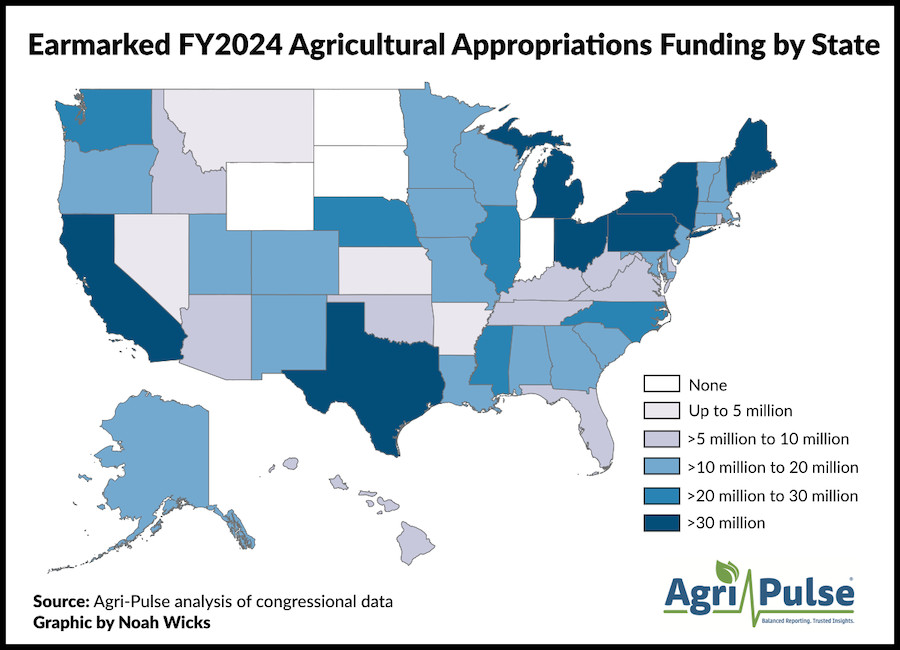Farm-state lawmakers are guiding more than $753 million in USDA funding to their home states in this fiscal year’s $26.22 billion Agriculture appropriations bill through a system that allows them to direct money to research facilities, hospitals, community buildings and other projects their constituents want.
Some $57.1 million is earmarked for the Agricultural Research Service, $14.2 million to the Animal and Plant Health Inspection Service, and $39.49 million to the Natural Resources Conservation Service. NRCS gets $19.14 million of that for conservation operations and $20.35 for watershed and flood prevention operations.
Rural Communities Facilities projects through the Rural Housing Service received $505 million in earmarks, according to an Agri-Pulse analysis of the appropriations bill, which funds the Food and Drug Administration as well as USDA. A total of $137 million went to Rural Utilities Service programs; $9.5 million of that to projects in the Distance Learning and Telemedicine Grants, $10.3 million for ReConnect program broadband projects and $117.48 million for rural water and wastewater disposal grants.
million for rural water and wastewater disposal grants.
A $25 million appropriation for ARS — the largest single earmark in the USDA bill — went to construction of a new National Center for Resilient and Regenerative Precision Agriculture. The earmark was requested by Sen. Deb Fischer and Rep. Mike Flood, both Nebraska Republicans.
The $160 million project, to be located on the University of Nebraska-Lincoln campus, will house four research units, including teams focused on precision agriculture and water, according to Fischer’s office. It is expected to double the number of ARS scientists in Nebraska to 150.
The new ARS center “will expand Nebraska’s already leading role in agricultural innovation,” Fischer said in a statement to Agri-Pulse. “This hub for research will … [be] focused on turning precision agriculture research into products and solutions in the field.”
Work on the project will begin this spring, a University of Nebraska press release says. The center had received $31.2 million in federal support, according to Fischer’s office. Some $11.2 million was for planning and design in 2021, $20 million was allocated in 2022 for construction.
A companion facility — the Ag Tech Incubator and Accelerator — is being built alongside the center. That project received $25 million in state funding in 2022, which was awarded with the stipulation that the university raise an additional $25 million of private funding.
The top Republican on the Senate Appropriations Committee, Susan Collins of Maine, secured the second-largest earmark, sending $10 million for the ARS New England Plant, Soil and Water Research Lab in Orono, Maine. A press release from Collins’ office says the money will be used to “modernize, renovate and expand existing facilities to support creation of a PFAS Center for Excellence.” Toxic PFAS, per- and polyfluoroalkyl substances, are known as “forever chemicals” found in soil and water.
It’s easy to be “in the know” about what’s happening in Washington, D.C. Sign up for a FREE month of Agri-Pulse news! Simply click here.
Collins began her effort to help build a PFAS research center last year when she requested $8 million in the FY23 appropriation. That funding, according to a press release, was used to purchase equipment for the University of Maine to monitor PFAS and to “fund research to help inform short-term management decisions for farms experiencing PFAS contamination.”
Maine is one of several states grappling with PFAs contamination. According to the Maine Organic Farmers and Gardeners Association, farmers have been applying PFAS-contaminated sludge to farmland in the state since the 1980s. The new funds, Collins said, would support research to better deter PFAS, its movement in soil, predict exposure, and mitigate impacts.”
With $52.7 million, Maine received the most USDA earmark funding in the bill. That amount includes $1.8 million to renovate the Stonington Wharf, described by Isle au Haut Boat Services President George Cole as “the only public transportation link” to part of Acadia National Park, through the Rural Community Facilities Program.
Other Maine allocations include $4 million for the renovation of an auditorium at the University of Maine, $2 million for a headquarters for the nonprofit Waldo Community Action Partners, $2.4 million for a public works facility in the town of Southwest Harbor, $2.6 million for a fire station in the town of Randolph and $3.4 million for expanding a state emergency alert systems hosted by the Maine Public Broadcasting Association.
Texas is No. 2 in earmarks with $42 million, while Pennsylvania is getting $41 million. California was allocated $32.9 million.
Rep. Barbara Lee, D-Calif., secured a $500,000 earmark for the Agricultural Research Service’s Western Regional Research Center in Albany.
Sen. Alex Padilla, D-Calif., and Reps. Jim Costa, D-Calif., and David Valadao, R-Calif., requested $1 million for Natural Resources Conservation Service work on the Seaborn Reservoir Project. According to Valadao’s website, the project aims to add approximately 4,000 acre feet of additional surface water supply storage for the Tulare area.
The third largest individual earmark, initially proposed by Sen. Cindy Hyde-Smith, R-Miss., would provide $9.05 million to the NRCS for watershed and flood prevention activities across eight Mississippi River watersheds. South Carolina Sen. Lindsay Graham, meanwhile, was able to secure $1.95 million from APHIS for Clemson University’s Livestock and Poultry Health Veterinary Diagnostic Center.
Rep. Dave Joyce, R-Ohio, and Sen. Sherrod Brown, D-Ohio, earmarked $6.75 million from the Community Facilities Program to improve the Hambden Volunteer Fire Department fire station.
Three other Community Facilities Program projects followed in terms of funding, each with $6 million: a facility for Alzheimers and dementia research in Wood County, Texas; a hospital in Comanche County, Oklahoma, and a police and fire complex in Vassar, Michigan.
For more news, go to www.agri-pulse.com.


